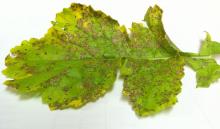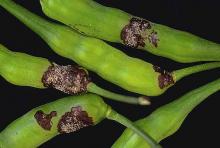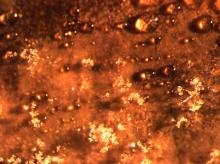See:
Seed Crop, Crucifers (Brassica, Eruca, and Raphanus spp.) - Downy Mildew (Staghead)
By C. M. Ocamb
Cause Peronospora parasitica (= Hyaloperonospora parasitica), a fungus-like microorganism that overwinters in roots or on leaves or stems of infected, living plants. Infected plant residues are possibly a source of new infections via oospores present in debris. Spores may be spread as contaminants on seeds but there is no proof that the microbe enters the seed. Nearly all cultivated plants and weeds in the Brassicaceae family are susceptible to this pathogen and seedlings may be more susceptible compared to older plants. Several strains of the pathogen are specific to certain groupings of crops. Resistance is being incorporated into commercial radish, and there are limited varieties that can be found in seed catalogs which are described as having resistance to downy mildew, but the resistance will depend on the genetics of pathogen population in the vicinity of a planting of these resistant varieties. The systemic phase of the disease is the most destructive.
High humidity, fog, drizzle, and heavy dew favor disease development and spread. Once P. parasitica has infected a plant, conidia are produced on aerial plant portions and can be dispersed by wind or splashing water to cause secondary spread of the disease. Moderate temperatures during the day time (68ºF to 75ºF) and a high relative humidity, fog, drizzling rains, or heavy dew favor disease development and spread. In areas with mild, wet winters, such as western Oregon or Washington, the pathogen can continue infecting fall-planted seed crops during the winter months, although only small amount of the total leaf surface area may be colonized on individual leaves, but this allows for a build-up within a field, potentially leading to severe increase in infections of spring growth if spring conditions are wet and mild. White rust and downy mildew are commonly found cohabitating together on brassicas and radish in western Oregon and elsewhere.
Symptoms The first observable symptom is small, light green-yellow lesions on the upper leaf surface, the leaf spots turn yellow on the upper leaf surface as lesions enlarge. During high humidity, a grayish-white mycelial growth appears on the underside of leaf spots as the pathogen produces spores. Leaf spots may become papery and die, especially if temperatures warm above 75ºF. When seedlings are attacked, sporulation may develop on both sides of the cotyledons, and death of the young plant can occur. Plants can become systemically colonized, especially if infected at the seedling stage, but the black streaking and discoloration inside storage roots does not become apparent until closer to harvest.
On fall-planted crops, downy mildew can create tiny leaf spots during the winter months or other times where small clusters of, even just a few, conidia and conidiophores are produced on the underside of the leaf surface; rarely in large enough quantity to be seen without magnification. During warmer rain breaks, individual lesions may rapidly enlarge and then quickly collapse with a secondary soft rot during rainy periods. This can be confused for cold-damaged tissues with subsequent secondary leaf rot, which can also be common in areas of Oregon and Washington during certain winters.
Cultural control
- Rotate out of crucifers for at least two years and avoid planting adjacent to a field infected the previous season.
- Utilize varieties with resitance to downy mildew. Red radish varieties with resistance include Autella, Danilo, Donato, Melito, and Robello; the white radish variety Whitella also has resistance.
- Eradicate cruciferous weeds (wild mustards, etc.) that may harbor this microorganism during rotations.
- Manage irrigation to reduce periods of high humidity.
- Spring-planted, summer-harvested crops have fewer problems than fall-harvested.
Chemical control Spraying for mildew requires completely covering the plant. In general, high-gallonage ground application has been more effective than aerial application.
- Copper products (Group M1) are not recommended as stand-alone materials.
Badge SC at 1 to 2.25 pints/A on 10-day intervals. Preharvest interval is 0 days. 24-hr reentry for greenhouse use; 48-hr reentry for all other applications.
- Phosphonates (Group P7; formerly Group 33) can be very effective.
- Fosphite at 1 to 3 quarts/A on 2- to 3-week intervals. Can be applied up to the day of harvest. 4-hr reentry.
- K-Phite 7LP at 1 to 4 quarts/A on 7- to 14-day intervals. Can be applied up to the day of harvest. 4-hr reentry.
- Rampart at 1 to 3 quarts/A on 2- to 3-week intervals. Can be applied up to the day of harvest. 4-hr reentry.
- Resist 57 at 1 to 3 quarts/A on 2- to 3-week intervals. 4-hr reentry.
- Regalia (Group P5) at 1 to 4 quarts/A plus another fungicide (or 2 to 4 quarts/A if used alone) on 7- to 10-day intervals. Does not benefit from the addition of an adjuvant. Preharvest interval is 0 days. 4-hr reentry. O
Biological control
- Actinovate Lawn & Garden at 0.5 to 1 teaspoon/gal water. H O
- Double Nickel LC at 1 to 6 quarts/A on 3- to 10-day intervals. Can be applied the day of harvest. 4-hr reentry. O
- Sonata at 2 to 4 quarts/A on 7- to 14-day intervals. Can be applied up to and on the day of harvest. 4-hr reentry. O
Reference Jang, P., and Safeeulla, K.M. 1990. Seedborne nature of Peronospora parasitica in Raphanus sativus. Proc. Indian Acad. Sci. (Plant Sci.) 100(4):255-258.
Nashaat, N.I. 2007. Downy Mildew. In: Rimmer, S.R., Shattuck, V.I., and Buchwaldt, L., editors. Compendium of Brassica Diseases. St. Paul, (MN): APS Press; p. 28-30.




